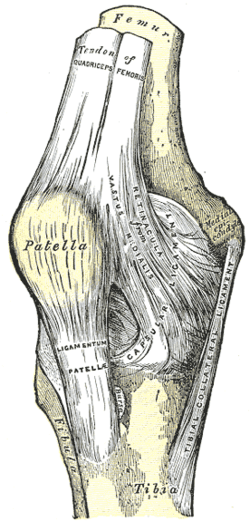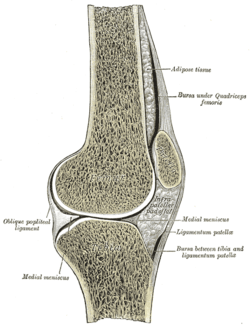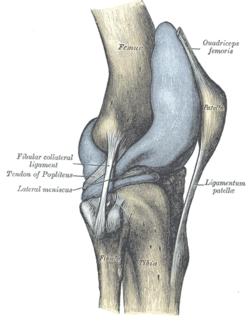Patellar ligament
The patellar ligament is the distal portion of the common tendon of the quadriceps femoris, which is continued from the patella to the tibial tuberosity. It is also sometimes called the patellar tendon[1] as it is a continuation of the quadriceps tendon.
| Patellar ligament | |
|---|---|
 Right knee-joint. Anterior view. (Ligamentum patellae visible at bottom left, below patella.) | |
| Details | |
| From | patella |
| To | tuberosity of the tibia |
| Identifiers | |
| Latin | ligamentum patellae |
| MeSH | D017847 |
| TA | A03.6.08.015 |
| FMA | 44581 |
| Anatomical terminology | |
Structure
The patellar ligament is a strong, flat, ligament, which originates on the apex of the patella distally and adjoining margins of the patella and the rough depression on its posterior surface; below, it inserts on the tuberosity of the tibia; its superficial fibers are continuous over the front of the patella with those of the tendon of the quadriceps femoris. It is about 4.5 cm long in adults (range from 3 to 6 cm).[2]
The medial and lateral portions of the quadriceps tendon pass down on either side of the patella to be inserted into the upper extremity of the tibia on either side of the tuberosity; these portions merge into the capsule, as stated above, forming the medial and lateral patellar retinacula.
The posterior surface of the patellar ligament is separated from the synovial membrane of the joint by a large infrapatellar pad of fat, and from the tibia by a bursa.
Clinical significance
The patellar ligament can be injured in a patellar tendon rupture. Because tendon does not regenerate fully in humans[3] there is a significant clinical need for research into therapies for patellar tendon rupture.
It can be used as a tissue source in the repair of other ligaments. In the event of a torn anterior cruciate ligament, the patellar ligament can be used in the rehabilitation process. In this case, the middle one third of the patellar ligament is harvested and inserted through tunnels that are drilled into the femur and tibia. The portion of the patellar ligament is then drawn through these tunnels in the bone and will be affixed to the bone via screws. The recovery process takes approximately 4–6 months upon the completion of surgery.[4] This patellar ligament method of reconstruction was traditionally the gold standard graft for anterior cruciate ligament reconstruction, and is still one of the more preferred methods.[5][6][7][8]
Its insertion on the tibia is the location of Osgood–Schlatter disease.
See also
Additional images
 Sagittal section of right knee-joint.
Sagittal section of right knee-joint. Capsule of right knee-joint (distended). Lateral aspect.
Capsule of right knee-joint (distended). Lateral aspect.- PATELLAR LIGAMENT.Deep dissection. Anterior view.
References
This article incorporates text in the public domain from page 340 of the 20th edition of Gray's Anatomy (1918)
- "Patellar tendon definition - Medical Dictionary definitions of popular medical terms easily defined on MedTerms". medterms.com. Retrieved 19 April 2018.
- Navali AM, Jafarabadi MA (2015). "Is There Any Correlation Between Patient Height and Patellar Tendon Length?". Arch Bone Jt Surg. 3 (2): 99–103. PMC 4468619. PMID 26110175.
- James, Roshan; Kesturu, Girish; Balian, Gary; Chhabra, A. Bobby (2008-01-01). "Tendon: Biology, Biomechanics, Repair, Growth Factors, and Evolving Treatment Options". Journal of Hand Surgery. 33 (1): 102–112. doi:10.1016/j.jhsa.2007.09.007. ISSN 0363-5023.
- MedlinePlus Encyclopedia ACL reconstruction
- Shaerf, Daniel A.; Pastides, Philip S.; Sarraf, Khaled M.; Willis-Owen, Charles A. (2014-01-18). "Anterior cruciate ligament reconstruction best practice: A review of graft choice". World Journal of Orthopedics. 5 (1): 23–29. doi:10.5312/wjo.v5.i1.23. PMC 3952691. PMID 24649411.
- Zakko, Philip; van Eck, Carola F.; Guenther, Daniel; Irrgang, James J.; Fu, Freddie H. (2015-07-17). "Can we predict the size of frequently used autografts in ACL reconstruction?". Knee Surgery, Sports Traumatology, Arthroscopy. 25 (12): 3704–3710. doi:10.1007/s00167-015-3695-4. ISSN 1433-7347. PMID 26183732.
- http://www.aaos.org/news/aaosnow/apr12/cover1.asp%5B%5D
- "Bone Patellar Bone ACL Reconstruction - Wheeless' Textbook of Orthopaedics". Retrieved 2008-10-23.
External links
- Anatomy figure: 15:01-04 at Human Anatomy Online, SUNY Downstate Medical Center - "Muscles of the anterior (extensor) compartment of the leg."
- lljoints at The Anatomy Lesson by Wesley Norman (Georgetown University) (antkneejointopenflexed)